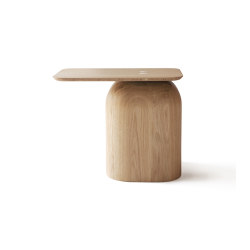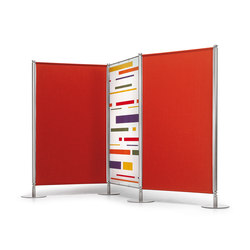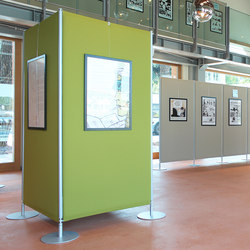Questo marchio è stato rimosso definitivamente. Le informazioni non sono più aggiornate.
Informazioni su Studio TK
MAGGIORI INFORMAZIONI SU STUDIO TK
Why Social
Shaping office culture and changing the culture of work
Social spaces are inherently dynamic. At the spatial level, they can be adapted to any company and work culture. At the individual level, they are responsive in the moment to all the ways people work and all that their work demands. Whereas traditional, one-size-fits-all workstations are often constrained by their own prescriptive nature, social spaces are freeing, promoting a culture of choice, connection and community across the office.
Empowering choice
With social spaces, people are free to choose how, where and with whom they do their best work. Whether catching up with colleagues, collaborating on a big project, or finding personal time to focus, social spaces offer a range of options for all types of work to occur simultaneously.
Fostering connections
Social spaces foster connections between people, work and the places they occupy, inviting novel thinking, promoting creativity and encouraging new opportunities to reveal themselves. When we connect the unconnected, information flows, allowing a productive work culture to thrive.
Building community
Social spaces are where people from across the office converge. They serve to both preserve company culture and spread it throughout the organization.
The Importance of Culture
Culture by Design
Companies are built on products and services, but sustained by culture. Culture establishes the context and values for how people communicate, engage and work together and with their customers. This has always been true, but the significance of culture is increasingly being recognized as a critical differentiator that gives organizations a sustainable, strategic advantage.
“Culture eats strategy for breakfast.” These words are attributed to educator and management consultant Peter Drucker. In his view, culture always prevails. Restructuring an organization or realigning its corporate strategy are ineffective measures if they don’t pay heed to the people and values that live at the core of every organization. Often, a company’s success or failure can be traced back to the resilience of its culture.
As the office continues to evolve from the place where all work happens toward a place where the organization comes to connect, culture has become a key mandate for workplace design – on par with performance. Cultural expression celebrates the identity and values the organization aspires to, while employee-centric experiences enable workers to choose how they want to work individually and as groups.
The workplace design mandate is to distill an organization’s values into an authentic expression that represents both the current identity as well as its aspirational future. It requires that we continually assess the changing needs of employees and constantly evolve to meet their shifting preferences and attitudes. Successful organizations integrate these into a coherent design that flows across workplace experiences and services.
No Two Cultures Are Alike
In today’s environment, companies rarely choose a one-size-fits-all approach. In fact, most of them rose to prominence because they were able to address the specific needs of an ever-evolving and discerning customer base. And just like their customers, they too have needs that are not only dynamic, but differ greatly from other companies.
To develop workplace solutions geared for the modern economy, we must recognize that every company has its own culture and that no two cultures are alike. Culture matters. As the guiding force in the workplace, it can influence how people express themselves and engage with their work and with others. Put another way, it signals everything the company stands for and nurtures the type of work and experiences that create a productive environment.
Nurturing a Culture of Work
The right space can nurture a work style best suited for the task at hand. Whether a company values transparency or privacy, collaboration or heads-down focus, a social space can dynamically be reconfigured to stimulate the work modality that best maximizes productivity and improves wellbeing.
It’s what Dr. Rob Goffee and Dr. Gareth Jones, professors of organization behavior, refer to as “the organization of your dreams.” Goffee and Jones believe that a company does its best work when it adheres to the following six principles: nurture the individual needs of employees, communicate openly and clearly, add value to rather than extract value from employees, stand for something bigger and with purpose, make the work intrinsically meaningful, and create rules people can believe in. As applied to workplace design, it can be the difference between a homogenous environment that is prescriptive and controlling and a dynamic workplace that is liberating and empowering.
Culture is Just the Start
Culture is key, but context is critical. Cultural expression needs to be integrated within a broader design agenda to maintain its relevancy and value. In the latest Perkins+Will Design and Insight survey, our industry foresees the increasing impact of organizational resiliency to major events, sustainability, employee health and wellness, multigenerational workforce and changing technology on architectural and interior design. Challenges or opportunities? Any organization’s approach toward these is perhaps its most significant cultural expression.
Why Social
Shaping office culture and changing the culture of work
Social spaces are inherently dynamic. At the spatial level, they can be adapted to any company and work culture. At the individual level, they are responsive in the moment to all the ways people work and all that their work demands. Whereas traditional, one-size-fits-all workstations are often constrained by their own prescriptive nature, social spaces are freeing, promoting a culture of choice, connection and community across the office.
Empowering choice
With social spaces, people are free to choose how, where and with whom they do their best work. Whether catching up with colleagues, collaborating on a big project, or finding personal time to focus, social spaces offer a range of options for all types of work to occur simultaneously.
Fostering connections
Social spaces foster connections between people, work and the places they occupy, inviting novel thinking, promoting creativity and encouraging new opportunities to reveal themselves. When we connect the unconnected, information flows, allowing a productive work culture to thrive.
Building community
Social spaces are where people from across the office converge. They serve to both preserve company culture and spread it throughout the organization.
The Importance of Culture
Culture by Design
Companies are built on products and services, but sustained by culture. Culture establishes the context and values for how people communicate, engage and work together and with their customers. This has always been true, but the significance of culture is increasingly being recognized as a critical differentiator that gives organizations a sustainable, strategic advantage.
“Culture eats strategy for breakfast.” These words are attributed to educator and management consultant Peter Drucker. In his view, culture always prevails. Restructuring an organization or realigning its corporate strategy are ineffective measures if they don’t pay heed to the people and values that live at the core of every organization. Often, a company’s success or failure can be traced back to the resilience of its culture.
As the office continues to evolve from the place where all work happens toward a place where the organization comes to connect, culture has become a key mandate for workplace design – on par with performance. Cultural expression celebrates the identity and values the organization aspires to, while employee-centric experiences enable workers to choose how they want to work individually and as groups.
The workplace design mandate is to distill an organization’s values into an authentic expression that represents both the current identity as well as its aspirational future. It requires that we continually assess the changing needs of employees and constantly evolve to meet their shifting preferences and attitudes. Successful organizations integrate these into a coherent design that flows across workplace experiences and services.
No Two Cultures Are Alike
In today’s environment, companies rarely choose a one-size-fits-all approach. In fact, most of them rose to prominence because they were able to address the specific needs of an ever-evolving and discerning customer base. And just like their customers, they too have needs that are not only dynamic, but differ greatly from other companies.
To develop workplace solutions geared for the modern economy, we must recognize that every company has its own culture and that no two cultures are alike. Culture matters. As the guiding force in the workplace, it can influence how people express themselves and engage with their work and with others. Put another way, it signals everything the company stands for and nurtures the type of work and experiences that create a productive environment.
Nurturing a Culture of Work
The right space can nurture a work style best suited for the task at hand. Whether a company values transparency or privacy, collaboration or heads-down focus, a social space can dynamically be reconfigured to stimulate the work modality that best maximizes productivity and improves wellbeing.
It’s what Dr. Rob Goffee and Dr. Gareth Jones, professors of organization behavior, refer to as “the organization of your dreams.” Goffee and Jones believe that a company does its best work when it adheres to the following six principles: nurture the individual needs of employees, communicate openly and clearly, add value to rather than extract value from employees, stand for something bigger and with purpose, make the work intrinsically meaningful, and create rules people can believe in. As applied to workplace design, it can be the difference between a homogenous environment that is prescriptive and controlling and a dynamic workplace that is liberating and empowering.
Culture is Just the Start
Culture is key, but context is critical. Cultural expression needs to be integrated within a broader design agenda to maintain its relevancy and value. In the latest Perkins+Will Design and Insight survey, our industry foresees the increasing impact of organizational resiliency to major events, sustainability, employee health and wellness, multigenerational workforce and changing technology on architectural and interior design. Challenges or opportunities? Any organization’s approach toward these is perhaps its most significant cultural expression.
MAGGIORI INFORMAZIONI SU STUDIO TK

















